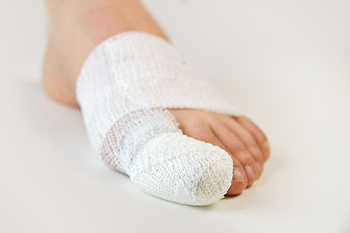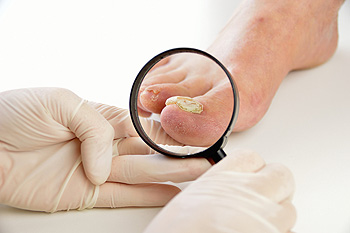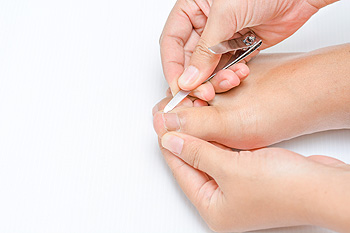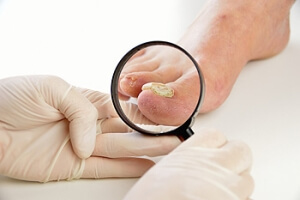Super User
How Are Broken Toes Treated?
 The bones that are located in each toe are known as phalanges. They can easily fracture if a heavy object falls on one or more of them, or if a toe is stubbed against a piece of furniture. Common symptoms many patients experience can include bruising, redness, and swelling, in addition to difficulty walking. Treatment can begin after a proper diagnosis is performed, which generally consists of having an X-ray taken. Treatment may consist of implementing a process that is referred to as buddy taping. It is a procedure that tapes the affected toe to the toe next to it, and this can be helpful in providing the stability that is needed as the healing process occurs. A broken toe is considered to be severe if the bone protrudes through the skin, and surgery may be necessary for complete healing. If you have fractured your toe, it is strongly suggested that you speak with a podiatrist as quickly as possible so they can determine what the best course of treatment is for you.
The bones that are located in each toe are known as phalanges. They can easily fracture if a heavy object falls on one or more of them, or if a toe is stubbed against a piece of furniture. Common symptoms many patients experience can include bruising, redness, and swelling, in addition to difficulty walking. Treatment can begin after a proper diagnosis is performed, which generally consists of having an X-ray taken. Treatment may consist of implementing a process that is referred to as buddy taping. It is a procedure that tapes the affected toe to the toe next to it, and this can be helpful in providing the stability that is needed as the healing process occurs. A broken toe is considered to be severe if the bone protrudes through the skin, and surgery may be necessary for complete healing. If you have fractured your toe, it is strongly suggested that you speak with a podiatrist as quickly as possible so they can determine what the best course of treatment is for you.
Broken toes may cause a lot of pain and should be treated as soon as possible. If you have any concerns about your feet, contact one of our podiatrists from New Tampa Foot & Ankle. Our doctors will treat your foot and ankle needs.
What Is a Broken Toe?
A broken toe occurs when one or more of the toe bones of the foot are broken after an injury. Injuries such as stubbing your toe or dropping a heavy object on it may cause a toe fracture.
Symptoms of a Broken Toe
- Swelling
- Pain (with/without wearing shoes)
- Stiffness
- Nail Injury
Although the injured toe should be monitored daily, it is especially important to have a podiatrist look at your toe if you have severe symptoms. Some of these symptoms include worsening or new pain that is not relieved with medication, sores, redness, or open wounds near the toe.
If you have any questions, please feel free to contact our office located in Wesley Chapel, FL . We offer the newest diagnostic and treatment technologies for all your foot care needs.
Types of Ankle Sprains
 A common injury among athletes is an ankle sprain. There are several types of ankle sprains that can occur. These can consist of injury to the ligaments on the outside of the ankle, which is called a lateral sprain. When the toes turn out while they are pointing up, the medial portion of the ankle can become hurt, and this type of sprain may take longer to heal. A sprain that occurs to the front or back ligaments is referred to as a syndesmotic sprain. Common symptoms that patients can experience with ankle sprains can include severe pain, swelling, and difficulty walking. Relief may be found when the impacted foot is elevated, as this may help to diminish a portion of the swelling. Additionally, existing bruising may be controlled when an ankle wrap is used, or a protective boot is worn. If you have sprained your ankle, it is strongly suggested that you speak with a podiatrist who can determine what the best treatment is for you.
A common injury among athletes is an ankle sprain. There are several types of ankle sprains that can occur. These can consist of injury to the ligaments on the outside of the ankle, which is called a lateral sprain. When the toes turn out while they are pointing up, the medial portion of the ankle can become hurt, and this type of sprain may take longer to heal. A sprain that occurs to the front or back ligaments is referred to as a syndesmotic sprain. Common symptoms that patients can experience with ankle sprains can include severe pain, swelling, and difficulty walking. Relief may be found when the impacted foot is elevated, as this may help to diminish a portion of the swelling. Additionally, existing bruising may be controlled when an ankle wrap is used, or a protective boot is worn. If you have sprained your ankle, it is strongly suggested that you speak with a podiatrist who can determine what the best treatment is for you.
Ankle sprains are common but need immediate attention. If you need your feet checked, contact one of our podiatrists from New Tampa Foot & Ankle. Our doctors can provide the care you need to keep you pain-free and on your feet.
How Does an Ankle Sprain Occur?
Ankle sprains take place when the ligaments in your ankle are torn or stretched beyond their limits. There are multiple ways that the ankle can become injured, including twisting or rolling over onto your ankle, putting undue stress on it, or causing trauma to the ankle itself.
What Are the Symptoms?
- Mild to moderate bruising
- Limited mobility
- Swelling
- Discoloration of the skin (depending on severity)
Preventing a Sprain
- Wearing appropriate shoes for the occasion
- Stretching before exercises and sports
- Knowing your limits
Treatment of a Sprain
Treatment of a sprain depends on the severity. Many times, people are told to rest and remain off their feet completely, while others are given an air cast. If the sprain is very severe, surgery may be required.
If you have suffered an ankle sprain previously, you may want to consider additional support such as a brace and regular exercises to strengthen the ankle.
If you have any questions please feel free to contact our office located in Wesley Chapel, FL . We offer the newest diagnostic and treatment technologies for all your foot and ankle needs.
How Fungal Toenail Infections Occur
 Fungal nail infections can occur in both the toenails and fingernails, and the infection causes the nails to become discolored, thickened, and brittle. Fungal nail infections are caused when various fungi, including mold and yeast, that live in moist environments enter the nails through small cracks. Fungal nail infections and skin infections, such as athlete’s foot, often occur together. Fungal nail treatment and antibiotics are likely needed in order for the infection to be properly treated. If you are experiencing a fungal nail infection, it is important that you visit a podiatrist.
Fungal nail infections can occur in both the toenails and fingernails, and the infection causes the nails to become discolored, thickened, and brittle. Fungal nail infections are caused when various fungi, including mold and yeast, that live in moist environments enter the nails through small cracks. Fungal nail infections and skin infections, such as athlete’s foot, often occur together. Fungal nail treatment and antibiotics are likely needed in order for the infection to be properly treated. If you are experiencing a fungal nail infection, it is important that you visit a podiatrist.
For more information about treatment, contact one of our podiatrists of New Tampa Foot & Ankle. Our doctors can provide the care you need to keep you pain-free and on your feet.
Toenail Fungus Treatment
Toenail fungus is a condition that affects many people and can be especially hard to get rid of. Fortunately, there are several methods to go about treating and avoiding it.
Antifungals & Deterrence
Oral antifungal medicine has been shown to be effective in many cases. It is important to consult with a podiatrist to determine the proper regiment for you, or potentially explore other options.
Applying foot powder on the feet and shoes helps keep the feet free of moisture and sweat.
Sandals or open toed shoes – Wearing these will allow air movement and help keep feet dry. They also expose your feet to light, which fungus cannot tolerate. Socks with moisture wicking material also help as well.
If you have any questions please feel free to contact our office located in Wesley Chapel, FL . We offer the newest diagnostic tools and technology to treat your foot and ankle needs.
How to Treat Your Toenail Fungus
While not a serious issue, toenail fungus, or onychomycosis, can be an embarrassing and uncomfortable condition to experience. Toenail fungus is often caused from public areas that harbor fungi and improper cleaning/drying of the foot. Once infected, the fungus grows deeper into the nail and can be very hard to get rid of.
There are different types of fungus that cause toenail fungus. Dermatophytes, yeasts, and molds are the most frequent forms of fungus to infect the toenail. Dermatophytes are the most common among the three. Symptoms associated with fungal nails include the discoloration of the toenail, brittleness, and in some circumstances, a smell. Pain is rarely a symptom caused by toenail fungus.
Diagnosis of fungal nails is generally a rather quick process. However podiatrists will make sure that the cause is not another condition such as lichen planus, psoriasis, onychogryphosis, or nail damage. Podiatrists will make use of fungal cultures and microscopy to verify that it is fungus.
While over-the-counter ointments are readily available, most are ineffective. This is due to the fact that the nail is very protective and that the fungus slips in between the nail plate and bed. Podiatrists can offer oral medication which currently provides the best results.
Ultimately, prevention is the best line of defense against toenail fungus. Avoid unsanitary public showers. If you do use a public shower, use shower shoes to provide your foot with protection. Once you are finished showering, make sure to thoroughly dry your feet. Fungi thrive in warm, dark, and moist places like sweaty, warm feet that are left dark in shoes all day.
How Does Cuboid Syndrome Occur?
 Cuboid subluxation is another term for the medical condition that is known as cuboid syndrome. It can happen when one of the cuboid bones slightly shifts, and a noticeable sign can be mild pain under the pinky toe. Additional symptoms can include a limited range of motion, swelling surrounding the impacted area, and the toes may feel weak. A common reason why this condition may occur can be from an ankle sprain, or from activities that invoke strain on the ligaments and bones. Other reasons why cuboid syndrome may occur can include walking or running on hills, wearing shoes that do not offer adequate support, or from being overweight. Moderate relief may be found when the foot is elevated, and additional support may be obtained when the foot is taped. If you feel you have developed this syndrome, it is advised that you schedule an appointment with a podiatrist who can offer treatment options that are correct for you.
Cuboid subluxation is another term for the medical condition that is known as cuboid syndrome. It can happen when one of the cuboid bones slightly shifts, and a noticeable sign can be mild pain under the pinky toe. Additional symptoms can include a limited range of motion, swelling surrounding the impacted area, and the toes may feel weak. A common reason why this condition may occur can be from an ankle sprain, or from activities that invoke strain on the ligaments and bones. Other reasons why cuboid syndrome may occur can include walking or running on hills, wearing shoes that do not offer adequate support, or from being overweight. Moderate relief may be found when the foot is elevated, and additional support may be obtained when the foot is taped. If you feel you have developed this syndrome, it is advised that you schedule an appointment with a podiatrist who can offer treatment options that are correct for you.
Cuboid syndrome, also known as cuboid subluxation, occurs when the joints and ligaments near the cuboid bone in the foot become torn. If you have cuboid syndrome, consult with one of our podiatrists from New Tampa Foot & Ankle. Our doctors will assess your condition and provide you with quality foot and ankle treatment.
Cuboid syndrome is a common cause of lateral foot pain, which is pain on the outside of the foot. The condition may happen suddenly due to an ankle sprain, or it may develop slowly overtime from repetitive tension through the bone and surrounding structures.
Causes
The most common causes of cuboid syndrome include:
- Injury – The most common cause of this ailment is an ankle sprain.
- Repetitive Strain – Tension placed through the peroneus longus muscle from repetitive activities such as jumping and running may cause excessive traction on the bone causing it to sublux.
- Altered Foot Biomechanics – Most people suffering from cuboid subluxation have flat feet.
Symptoms
A common symptom of cuboid syndrome is pain along the outside of the foot which can be felt in the ankle and toes. This pain may create walking difficulties and may cause those with the condition to walk with a limp.
Diagnosis
Diagnosis of cuboid syndrome is often difficult, and it is often misdiagnosed. X-rays, MRIs and CT scans often fail to properly show the cuboid subluxation. Although there isn’t a specific test used to diagnose cuboid syndrome, your podiatrist will usually check if pain is felt while pressing firmly on the cuboid bone of your foot.
Treatment
Just as the range of causes varies widely, so do treatments. Some more common treatments are ice therapy, rest, exercise, taping, and orthotics.
If you have any questions, please feel free to contact our office located in Wesley Chapel, FL . We offer the newest diagnostic and treatment technologies for all your foot care needs.
Cuboid Syndrome
Cuboid syndrome mostly affects athletes, although it can affect non-athletes too. It is also known as cuboid subluxation or cuboid fault syndrome. This condition occurs when joints and ligaments near the cuboid bone of the foot are damaged, or when the cuboid bone itself is dislodged from its natural position. It is usually marked by pain on the outer side of the foot, which may be persistent or may come and go. Cuboid syndrome can be difficult to diagnose unless it becomes severe and more noticeable. Your doctor will likely ask questions about when the pain began and how long it has been present, and will put pressure on the cuboid bone to determine if that area is the origin of the pain.
Causes of Cuboid Syndrome
- Any repetitive stresses placed on the foot due to athletic activities are a common cause of cuboid syndrome.
- Although it develops over time, it is possible that this syndrome can occur all of sudden due to a single event or injury.
- Over-pronation can exacerbate the condition if not corrected.
Disagreements Amongst Podiatrists Regarding Cuboid Syndrome
- Some refer to it as the dislocation of the calcaneal-cuboid joint only.
- Other podiatrists see it as an injury of the ligaments located nearby, which also involves the cuboid bone.
It is very important that when you experience any kind of pain on the side of your foot, you should seek medical care right away. If a subluxed cuboid is caught early, your feet may respond well to the treatment, and you can get back into sports or other activities again as soon as the pain subsides.
Is a Career in Podiatry a Good Choice for Me?
 The field of medicine which is referred to as podiatry involves diagnosing and treating foot conditions. These can include plantar fasciitis, ingrown toenails, corns, and ankle injuries. Mandatory education consists of obtaining a bachelor's degree, followed by enrolling in a school of podiatric medicine. This program typically takes four years to complete, and then the student becomes a Doctor of Podiatric Medicine (DPM) after three years of working in a residency environment. Residencies often include working at hospitals, where surgical and medical experience can be achieved. Many podiatrists can prescribe medication, perform foot and ankle surgery, and treat diabetic patients. If you are interested in pursuing a career in podiatry, it is suggested that you speak with a podiatrist who can address any questions you may have.
The field of medicine which is referred to as podiatry involves diagnosing and treating foot conditions. These can include plantar fasciitis, ingrown toenails, corns, and ankle injuries. Mandatory education consists of obtaining a bachelor's degree, followed by enrolling in a school of podiatric medicine. This program typically takes four years to complete, and then the student becomes a Doctor of Podiatric Medicine (DPM) after three years of working in a residency environment. Residencies often include working at hospitals, where surgical and medical experience can be achieved. Many podiatrists can prescribe medication, perform foot and ankle surgery, and treat diabetic patients. If you are interested in pursuing a career in podiatry, it is suggested that you speak with a podiatrist who can address any questions you may have.
If you are experiencing pain in the feet or ankles, don’t join the stubborn majority refusing treatment. Feel free to contact one of our podiatrists from New Tampa Foot & Ankle. Our doctors can provide the care you need to keep you pain-free and on your feet.
What Is a Podiatrist?
Someone would seek the care of a podiatrist if they have suffered a foot injury or have common foot ailments such as heal spurs, bunions, arch problems, deformities, ingrown toenails, corns, foot and ankle problems, etc.
Podiatric Treatment
A podiatrist will treat the problematic areas of the feet, ankle or lower leg by prescribing the following:
- Physical therapy
- Drugs
- Orthotic inserts or soles
- Surgery on lower extremity fractures
A common podiatric procedure a podiatrist will use is a scanner or force plate which will allow the podiatrist to know the designs of orthotics. Patients are then told to follow a series of tasks to complete the treatment. The computer will scan the foot a see which areas show weight distribution and pressure points. The podiatrist will read the analysis and then determine which treatment plans are available.
If you have any questions please feel free to contact our office located in Wesley Chapel, FL . We offer the newest diagnostic and treatment technologies for all your foot and ankle needs.
Practicing Foot Care May Help to Prevent Painful Conditions
 Research has indicated patients that maintain everyday foot care may be less likely to develop painful foot conditions. Twenty-five percent of the bones in the body are located in the feet, and it is beneficial to practice daily foot care which may help the feet to feel good. Wearing appropriate shoes while in public areas may help to prevent fungal infections from developing, which can include athlete’s foot and toenail fungus. Corns that can develop on the bottom of the foot or between the toes may be avoided when shoes are worn that fit properly. Additionally, this may help to avoid ingrown toenails from developing. A bony protrusion that develops on the side of the big toe is referred to as a bunion, and this may be prevented when the correct style shoes are worn. If you would like additional information about the importance of practicing everyday foot care, please consult with a podiatrist.
Research has indicated patients that maintain everyday foot care may be less likely to develop painful foot conditions. Twenty-five percent of the bones in the body are located in the feet, and it is beneficial to practice daily foot care which may help the feet to feel good. Wearing appropriate shoes while in public areas may help to prevent fungal infections from developing, which can include athlete’s foot and toenail fungus. Corns that can develop on the bottom of the foot or between the toes may be avoided when shoes are worn that fit properly. Additionally, this may help to avoid ingrown toenails from developing. A bony protrusion that develops on the side of the big toe is referred to as a bunion, and this may be prevented when the correct style shoes are worn. If you would like additional information about the importance of practicing everyday foot care, please consult with a podiatrist.
Everyday foot care is very important to prevent infection and other foot ailments. If you need your feet checked, contact one of our podiatrists from New Tampa Foot & Ankle. Our doctors can provide the care you need to keep you pain-free and on your feet.
Everyday Foot Care
Often, people take care of their bodies, face and hair more so than they do for their feet. But the feet are a very important aspect of our bodies, and one that we should pay more attention to. Without our feet, we would not be able to perform most daily tasks.
It is best to check your feet regularly to make sure there are no new bruises or cuts that you may not have noticed before. For dry feet, moisturizer can easily be a remedy and can be applied as often as necessary to the affected areas. Wearing shoes that fit well can also help you maintain good foot health, as well as making it easier to walk and do daily activities without the stress or pain of ill-fitting shoes, high heels, or even flip flops. Wearing clean socks with closed shoes is important to ensure that sweat and bacteria do not accumulate within the shoe. Clean socks help to prevent Athlete’s foot, fungi problems, bad odors, and can absorb sweat.
If you have any questions please feel free to contact our office located in Wesley Chapel, FL . We offer the newest diagnostic and treatment technologies for all your foot and ankle needs.
Common Symptoms of Plantar Fasciitis
 Research has indicated plantar fasciitis is the reason many patients have heel pain. It is an inflammation of the plantar fascia, which is the portion of tissue on the sole of the foot that connects the heel to the toes. The reasons why this area may become torn or damaged can consist of standing for long periods of time throughout the day, and wearing shoes that do not fit correctly. The symptoms that many patients experience can include heel pain that may be more noticeable upon arising in the morning, and limping may become natural to ease the pain and discomfort. Specific stretches can be performed that may bring mild relief, and wearing custom made orthotics may provide extra arch support. If you have heel pain, please consult with a podiatrist who can properly diagnose plantar fasciitis, and successfully treat this condition.
Research has indicated plantar fasciitis is the reason many patients have heel pain. It is an inflammation of the plantar fascia, which is the portion of tissue on the sole of the foot that connects the heel to the toes. The reasons why this area may become torn or damaged can consist of standing for long periods of time throughout the day, and wearing shoes that do not fit correctly. The symptoms that many patients experience can include heel pain that may be more noticeable upon arising in the morning, and limping may become natural to ease the pain and discomfort. Specific stretches can be performed that may bring mild relief, and wearing custom made orthotics may provide extra arch support. If you have heel pain, please consult with a podiatrist who can properly diagnose plantar fasciitis, and successfully treat this condition.
Plantar fasciitis can be very painful and inconvenient. If you are experiencing heel pain or symptoms of plantar fasciitis, contact one of our podiatrists from New Tampa Foot & Ankle. Our doctors can provide the care you need to keep you pain-free and on your feet.
What Is Plantar Fasciitis?
Plantar fasciitis is the inflammation of the thick band of tissue that runs along the bottom of your foot, known as the plantar fascia, and causes mild to severe heel pain.
What Causes Plantar Fasciitis?
- Excessive running
- Non-supportive shoes
- Overpronation
- Repeated stretching and tearing of the plantar fascia
How Can It Be Treated?
- Conservative measures – anti-inflammatories, ice packs, stretching exercises, physical therapy, orthotic devices
- Shockwave therapy – sound waves are sent to the affected area to facilitate healing and are usually used for chronic cases of plantar fasciitis
- Surgery – usually only used as a last resort when all else fails. The plantar fascia can be surgically detached from the heel
While very treatable, plantar fasciitis is definitely not something that should be ignored. Especially in severe cases, speaking to your doctor right away is highly recommended to avoid complications and severe heel pain. Your podiatrist can work with you to provide the appropriate treatment options tailored to your condition.
If you have any questions please feel free to contact our office located in Wesley Chapel, FL . We offer the newest diagnostic and treatment technologies for all your foot and ankle needs.
Foot and Ankle Injuries Are Common
 There are many people who develop some type of foot or ankle condition at various points in their lives. Patients who frequently participate in running and jumping activities may be more susceptible in developing uncomfortable foot ailments. These can include sprained ankles, Achilles tendon injuries, or plantar fasciitis. Sever’s disease generally develops among young teenagers, and may impact the growth plate in the heel. Parents may notice their children are limping, and may have difficulty walking in the morning. Bruises may accompany a sudden ankle injury, and this typically causes pain and discomfort. Additionally, stress fractures can gradually occur from repetitive motion that often comes from engaging in sports that include basketball and volleyball. If you have had a foot injury, it is suggested that you consult with a podiatrist as quickly as possible so the correct treatment plan can begin.
There are many people who develop some type of foot or ankle condition at various points in their lives. Patients who frequently participate in running and jumping activities may be more susceptible in developing uncomfortable foot ailments. These can include sprained ankles, Achilles tendon injuries, or plantar fasciitis. Sever’s disease generally develops among young teenagers, and may impact the growth plate in the heel. Parents may notice their children are limping, and may have difficulty walking in the morning. Bruises may accompany a sudden ankle injury, and this typically causes pain and discomfort. Additionally, stress fractures can gradually occur from repetitive motion that often comes from engaging in sports that include basketball and volleyball. If you have had a foot injury, it is suggested that you consult with a podiatrist as quickly as possible so the correct treatment plan can begin.
Foot and ankle trauma is common among athletes and the elderly. If you have concerns that you may have experienced trauma to the foot and ankle, consult with one of our podiatrists from New Tampa Foot & Ankle. Our doctors will assess your condition and provide you with quality foot and ankle treatment.
Foot and ankle trauma cover a range of injuries all over the foot; common injuries include:
- Broken bones
- Muscle strains
- Injuries to the tendons and ligaments
- Stress fractures
Symptoms
Symptoms of foot and ankle injuries vary depending on the injury, but more common ones include:
- Bruising
- Inflammation/ Swelling
- Pain
Diagnosis
To properly diagnose the exact type of injury, podiatrists will conduct a number of different tests. Some of these include sensation and visual tests, X-rays, and MRIs. Medical and family histories will also be taken into account.
Treatment
Once the injury has been diagnosed, the podiatrist can than offer the best treatment options for you. In less severe cases, rest and keeping pressure off the foot may be all that’s necessary. Orthotics, such as a specially made shoes, or immobilization devices, like splints or casts, may be deemed necessary. Finally, if the injury is severe enough, surgery may be necessary.
If you have any questions, please feel free to contact our office located in Wesley Chapel, FL . We offer the newest diagnostic and treatment technologies for all your foot care needs.








